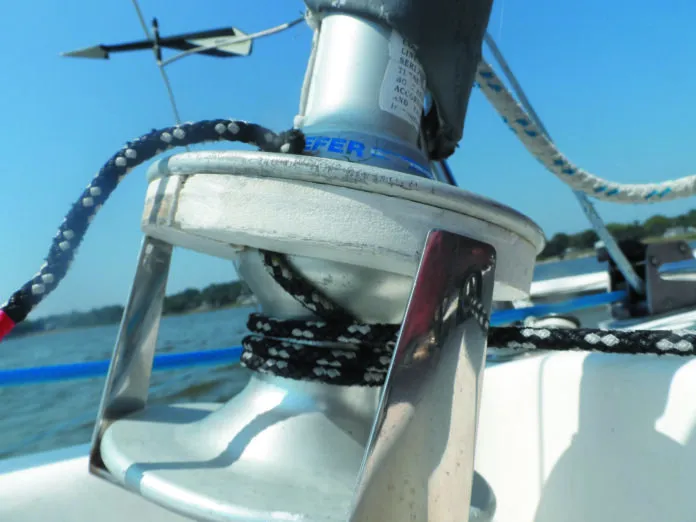I’d heard Azek described as a low cost alternative to Starboard, but never paid much attention. I’d used a few boards around the house, and used it for a few non-structural spacers on the boat. I knew it to be weaker that wood and I was unsure of its durability. Then I heard of a guy making commercial crab skiffs on the Chesapeake Bay entirely from this material, using mostly traditional building methods. Obviously, it deserved a closer look.
Generically, Azek is referred to cellular polyvinyl chloride (PVC), PVC trim board, or PVC appearance board. Azek Trim Board and Versatex Veranda are most common in lumber yards and big box stores, where they stock a full line of dimensional lumber, ¼-inch, and ½-inch sheets in matt white. Veranda is very slightly harder, Azek has smoother corner rounds, and both have ardent fans.Cellular PVC board sheets by Celtec and Sintra,used primarily for signs, are available in colors.
We will focus on Azek Trim Board and Versatex Veranda, since they are widely available, we have experience with them, and there are more marine field reports from boats that have put these materials into service.
These PVC board is really nothing like Starboard (LDPE). A better comparison would be a fine grained, lightweight, and rot-proof version of medium density fiberboard (MDF). Based on the same PVC plastic as familiar PVC pipe, the surface is a 10 mil layer of smooth plastic, and the core is a very dense closed-cell micro-foam.
It shares some properties with PVC pipe; it is waterproof, UV resistant (house trim is the primary application), and it glues easily with both PVC pipe cement and a variety of cellular PVC-specific adhesives. The cellular core changes other properties; it has about the same density as fir and pine (though considerably less stiff and strong), is more flexible and does not become brittle above freezing temperatures. It machines like fine-grained wood, and cut edges can be bonded with a wide range of adhesives, including familiar epoxy and polyurethane sealants (see “Marine Sealant Adhesion Test,” PS November 2017). See the table on page 17 for a comparison of mechanical properties.
STRENGTH AND STIFFNESS
Having only 25-35 percent of the strength and 10 percent of the stiffness of wood limits use to non-structural and compression-only applications. Like plywood and MDF, it’s physical properties are the same in all directions.
MACHINING
Standard woodworking methods work fine, with an emphasis on sharp blades and light feed pressure to avoid chipping and melting. It does not split, is not prone to chipping, and can be worked to more precise tolerances than plywood or soft wood. For bonding, sand to 100 grit. Cuts with a sharp circular saw generally do not require sanding for bonding. We suggest 300 grit before painting for a better finish. However, since the cells vary in size, you will never get a perfect finish without multiple coats or sealing first.
Some users advise wiping the cut edges with acetone to seal them and reducing dirt attraction, but we tried it and found it helps only a little. If you want a finished edge, white paint is the better option. Use miters when possible to conceal cut edges.
BENDING AND FASTENING
PVC trim board can be vacuum formed and more easily bent into curves than wood, especially when heated. The thermal deflection temperature is 140F. If the bending is done cold, extra attention must be paid to securing the edges, since it is softer than wood and the fasteners can tear out.
Thermal expansion is greater than wood, which can be noticeable on long boards on houses, but it’s about the same as Starboard and fiberglass. If painted, light colors are recommended to reduce heat buildup.
It is weaker at holding fasteners than soft wood or Starboard. Gluing screws increases the hold to nearly that of wood, but you won’t get them out. Gluing edges, in addition to fasteners, can result in a strong structure.
BONDING
PVC cements fuse it into one piece, and pipe cement works fine. The working time is a little short for large joints on houses, but as long as you dry fit the parts first, it is sufficient for most boatsized projects. Because the joint is not constrained, like a PVC pipe fitting, it does not grab instantly, and you have several minutes to wiggle it into place. Azek sells a specialty product that has 6-10 minute working time and 24 hour cure. Both are a little runny and neat working habits are mandatory. White Hot makes a gelled version that is neater to work with. Epoxy also works well, as reported by West Systems and confirmed by our tests. In fact, all of these bonding methods will result in the material itself failing, not the joint.
PAINTING
Latex paint and marine paints work. Krylon Fusion (for outdoor PVC lawn furniture) works well. Primers can’t hurt but don’t seem vital. Use light colors; heat build-up causes excessive expansion.
A 0.5” x 4 x 8 sheet sells for about $85 at a home supply store. This is good for utility boxes, panels, and light duty companionway boards. For $16, a 0.75” x 3.5” x 8’ board is more than enough to make your own ladder treads (its too weak to use as a ladder step).
We’ve used Azek successfully for a number of low-stress application, including replacing a previous rotted wood spacer on our furler drum. The combination of accurate machining, rot and UV resistance, and light weight makes it the ideal material for jobs like that. Starboard would have also been very good. Solid fiberglass would be overkill. It’s too heavy, and more difficult to shape.



































